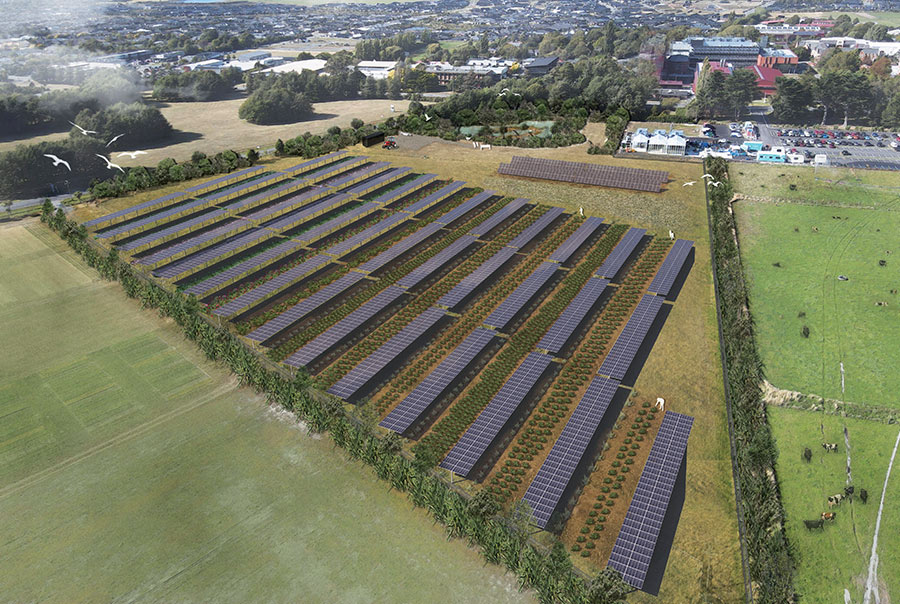
NORTH & SOUTH + Lincoln University

A visualisation of the new agrivoltaic Lincoln University Energy Farm by Boffa Miskell
Harvesting the sun
A new farm at Lincoln University will be the first in New Zealand to produce renewable energy as well as high-value crops.
Currently awaiting resource consent, the Lincoln University Energy Farm will comprise around 2,800 solar panels arranged in 14 rows across four hectares near the campus, generating around 2.3 GWh of solar energy per year.
But it’s what’s happening underneath and between the panels that’s truly groundbreaking.
Agrivoltaics—a portmanteau of agriculture and photovoltaics—refers to the dual use of land for both agricultural production and solar electricity and the Lincoln University Energy Farm is set to be the first in New Zealand to tackle this ambitious hybrid approach.
Agrivoltaics—a portmanteau of agriculture and photovoltaics— refers to the dual use of land for both agricultural production and solar electricity.
“One of the University’s important objectives is to decarbonise our campus, so we’re shutting down our coal-fired boiler next year and replacing it with renewable electricity, and a significant amount will come from our own Energy Farm, essentially a solar farm, but with a twist,” explains Dr. Shannon Page, Head of the Department of Environmental Management.
With an estimated 14,000 hectares expected to be covered in solar panels over the next five to six years Lincoln University wants to show that you can do more with these farms than graze sheep.
“We really wanted to explore the best use of this land,” Dr Page says. “What other crops can we grow, rather than just pasture, to really maximise agricultural productivity?”
The panels don’t just shade the crops; they create a whole new environment. Less sunlight means less heat stress and lower evaporation, which could be a boon for certain plants. The range of crops being tested under the solar panels is diverse. From perennial berry crops, which promise yields for years to come, to annual vegetable crops ideal for student research. Ornamental crops like peonies, will add another layer of diversity and economic potential to the project.
“By experimenting with a range of crops, we’re not only enhancing our understanding of agrivoltaics but also providing valuable research opportunities for our students,” Dr Shannon Page says. “They’re designing crop trials, managing the farm’s operations, and directly contributing to the evolution of sustainable agriculture.”
The solar farm is more than just an agricultural experiment; it’s a step toward Lincoln University’s plan to be carbon neutral by 2030. Next year, they will be switching to 100% carbon-free electricity, with 18% of it generated on-site. Additionally, when the eclectic tractor arrives, the Energy Farm will be able to demonstrate a completely fossil fuel-free operation.
Most of this energy will stay on campus, but during low-demand periods, Lincoln plans to share the surplus with the local community. It’s a win-win: the university gets greener, and the neighbours get a little extra juice for their toasters and Dr Shannon Page and his team are proving that with innovation, you can have your solar energy and eat your blueberries too.
